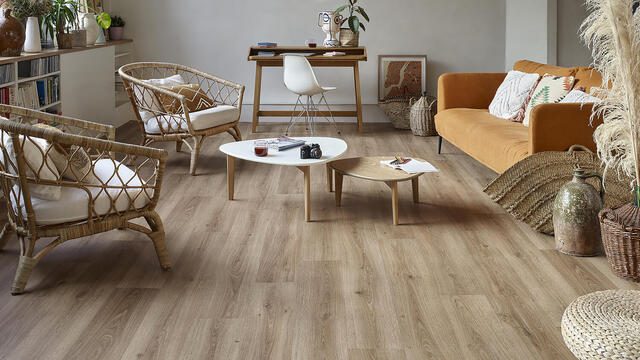When it comes to home improvement, few decisions have as much impact as choosing the right flooring. Not only does flooring affect the overall aesthetics of a space, but it also plays a crucial role in durability, maintenance, and comfort. In recent years, according to the professionals at Hardwood Planet, three types of flooring have gained immense popularity for their versatility, affordability, and aesthetic appeal: vinyl, laminate, and engineered hardwood.
Vinyl Flooring: The Modern Marvel
Vinyl flooring has undergone a remarkable transformation, shedding its outdated image to emerge as a modern and stylish flooring option. This synthetic material has become a favorite for homeowners seeking a balance between affordability and durability. Vinyl flooring is available in a variety of styles, including planks and tiles, and can mimic the appearance of natural materials like wood or stone.
One of the standout features of vinyl flooring is its water resistance. This makes it an ideal choice for high-moisture areas such as kitchens and bathrooms. Vinyl is also known for being comfortable underfoot, thanks to its softer surface compared to traditional hardwood or tile. The installation process is relatively straightforward, often involving a click-and-lock system that allows for easy DIY projects.
Cleaning and Maintaining Vinyl Flooring
Vinyl flooring is renowned for its durability, making it one of the easiest flooring types to clean and maintain. Regular sweeping or vacuuming helps remove loose dirt and debris, while damp mopping with a mild cleaner is sufficient for most stains. The impermeable surface of vinyl prevents water damage, making it an excellent choice for areas prone to spills, such as kitchens and bathrooms.
Vinyl flooring also boasts resistance to scratches and stains, reducing the need for intensive maintenance. However, it is essential to avoid abrasive cleaners or tools that could potentially damage the protective wear layer. While vinyl is relatively low-maintenance, it is wise to use furniture pads to prevent indentations from heavy objects over time.

Laminate Flooring: Affordable Elegance
Laminate flooring has earned its reputation as a cost-effective alternative to hardwood without sacrificing aesthetics. Composed of layers of synthetic materials fused together, laminate flooring is durable, resistant to scratches and stains, and often more budget-friendly than natural wood options.
One of the key advantages of laminate flooring is its versatility in design. Manufacturers use advanced printing techniques to create realistic wood, stone, or tile patterns, providing homeowners with a wide array of aesthetic choices. The installation process is typically simple, involving a floating floor system that does not require glue or nails. Laminate flooring is also known for its easy maintenance, making it an excellent option for busy households.
Cleaning and Maintaining Laminate Flooring
Laminate flooring shares some characteristics with vinyl in terms of ease of maintenance. Its wear layer provides resistance to scratches and stains, making it a suitable option for high-traffic areas. Regular sweeping or vacuuming helps remove dirt and debris, and damp mopping with a laminate floor cleaner ensures a clean surface.
However, laminate is more susceptible to moisture than vinyl. Excessive water exposure can cause swelling or warping, so it’s important to wipe up spills promptly. Unlike vinyl, laminate can be sensitive to cleaning products, so it’s advisable to use cleaners specifically designed for laminate flooring. Furniture pads are also recommended to prevent scratches and dents.

Engineered Hardwood: Timeless Elegance with Modern Innovation
For those who crave the warmth and classic appeal of hardwood but are mindful of budget constraints and environmental considerations, engineered hardwood stands as an excellent compromise. Engineered hardwood is composed of a real wood veneer layer atop layers of high-quality plywood or fiberboard. This construction not only imparts the authentic look and feel of hardwood but also enhances stability, making it less susceptible to expansion and contraction due to changes in humidity.
The versatility of engineered hardwood allows for installation in areas where solid hardwood may be impractical, such as basements or rooms with fluctuating moisture levels. Homeowners can choose from a variety of wood species, finishes, and plank widths to achieve a customized and upscale appearance. Although the initial cost may be higher than that of vinyl or laminate, the longevity and timeless elegance of engineered hardwood often make it a worthwhile investment.
Cleaning and Maintaining Engineered Hardwood Flooring
Engineered hardwood, while offering the timeless beauty of wood, requires more cautious maintenance compared to vinyl and laminate. It shares similarities with solid hardwood in terms of susceptibility to moisture, so spills should be promptly cleaned to prevent damage. However, the layered construction provides more stability, reducing the risk of warping.
Sweeping or vacuuming with a soft brush attachment is recommended for regular cleaning, and a damp mop with a hardwood floor cleaner can be used for deeper cleaning. It’s essential to avoid excessive water, as prolonged exposure can lead to issues. Engineered hardwood floors may also benefit from periodic refinishing, depending on the thickness of the top veneer.

Comparing Cleaning and Maintenance of Vinyl, Laminate, and Engineered Hardwood Flooring
While all three flooring options are relatively easy to maintain, there are key differences in their resistance to moisture, susceptibility to scratches, and long-term care requirements. Vinyl stands out for its resilience and water resistance, making it a hassle-free choice. Laminate offers stain resistance and straightforward cleaning but requires caution with moisture. Engineered hardwood requires more care due to its real wood veneer but provides an elegant and environmentally friendly flooring solution. Ultimately, the choice between vinyl, laminate, and engineered hardwood will depend on individual preferences, lifestyle factors, and the specific demands of the space.
Conclusion
The flooring landscape for home improvement has evolved, offering homeowners a diverse range of options that cater to different preferences and budgets. Vinyl, laminate, and engineered hardwood have risen to prominence, each bringing its own unique set of benefits to the table. Whether you prioritize water resistance, affordability, or the timeless beauty of wood, these flooring options allow you to transform your home with style and practicality.





